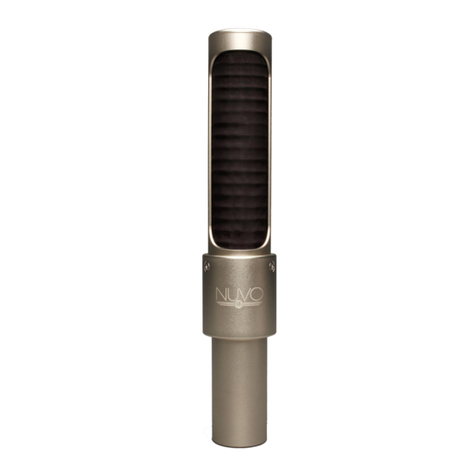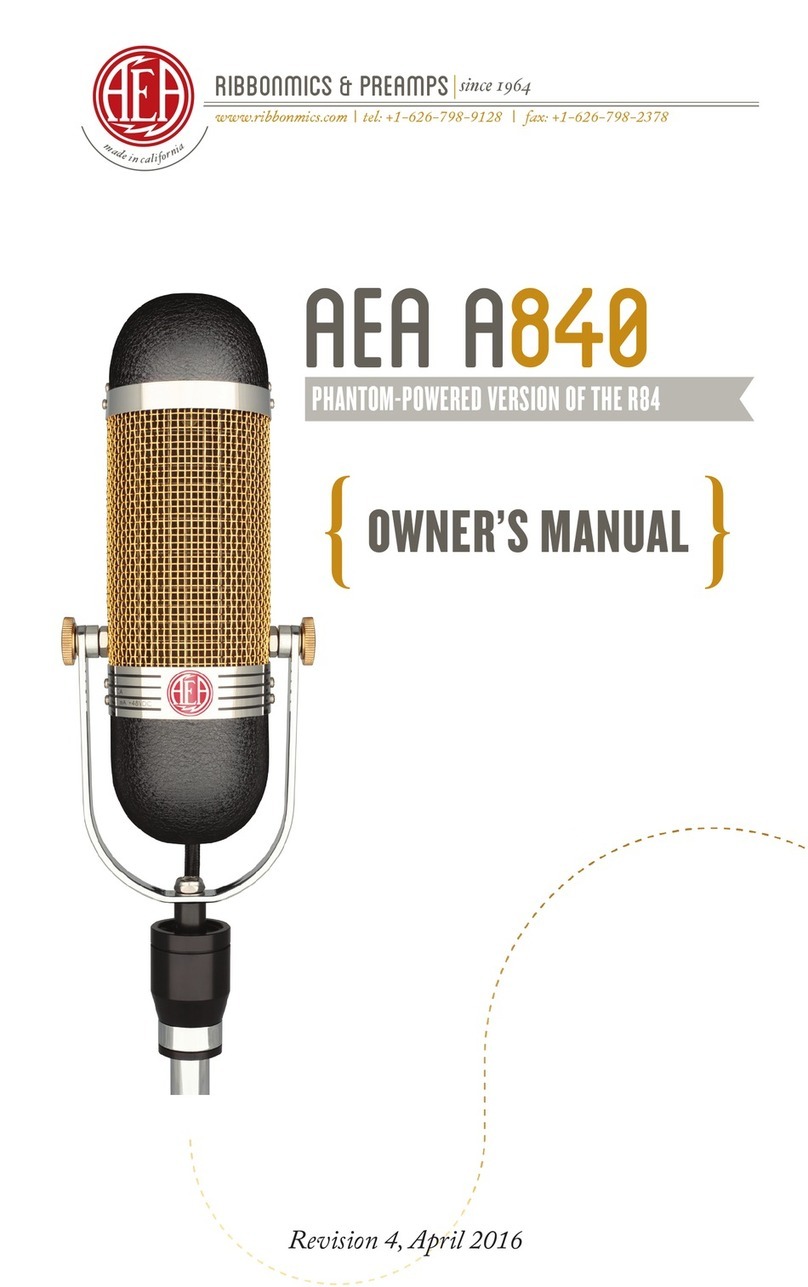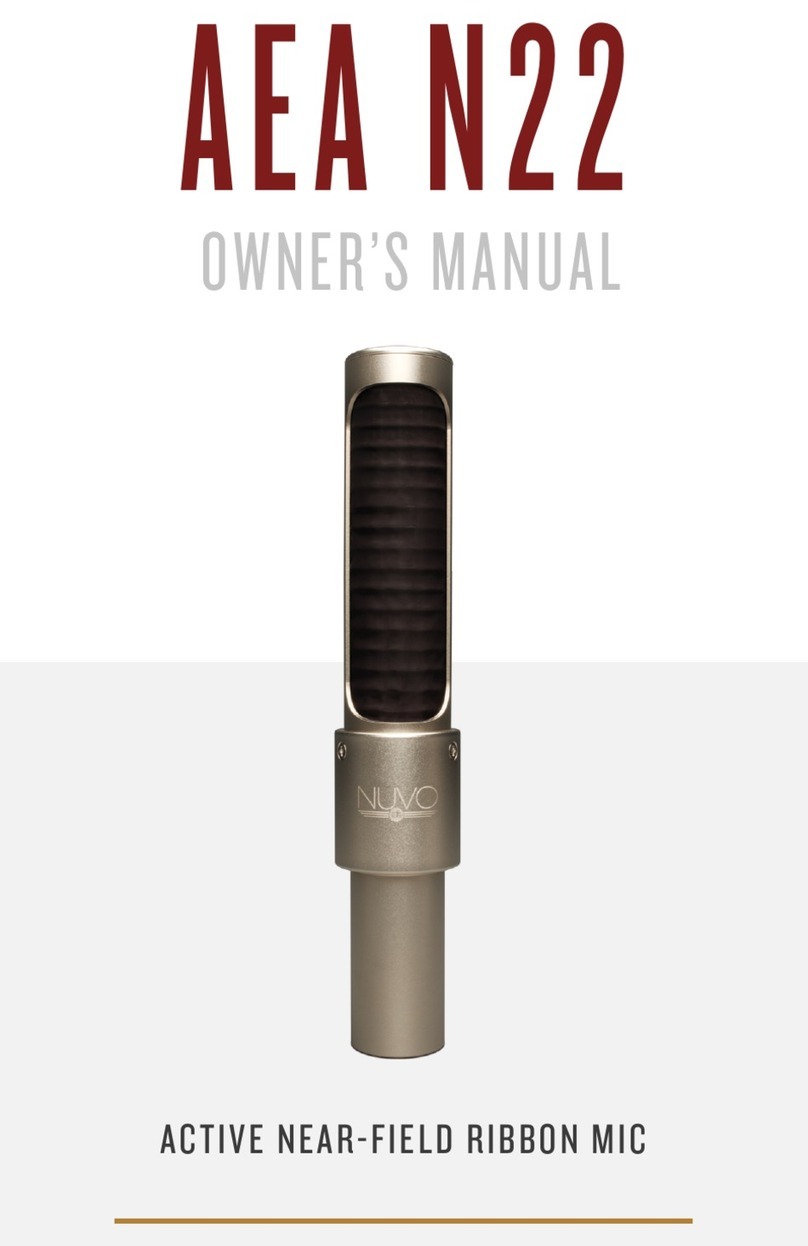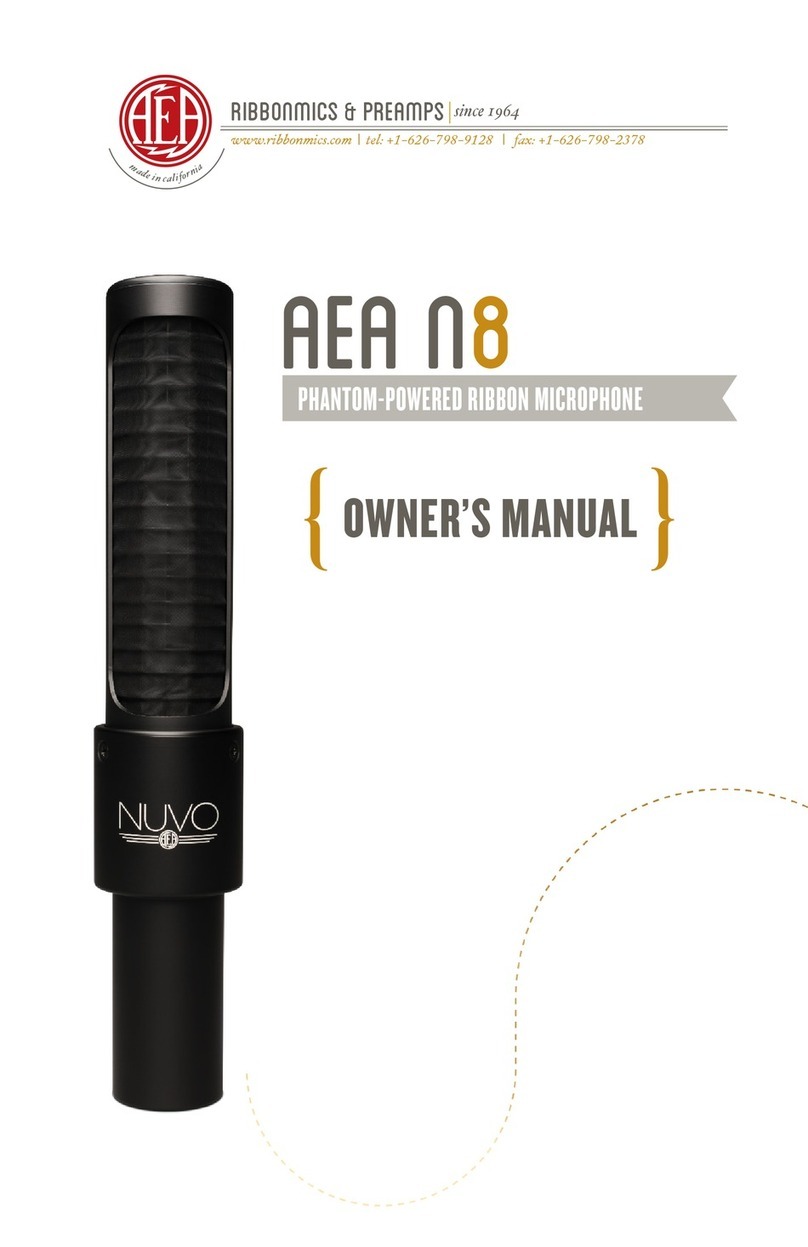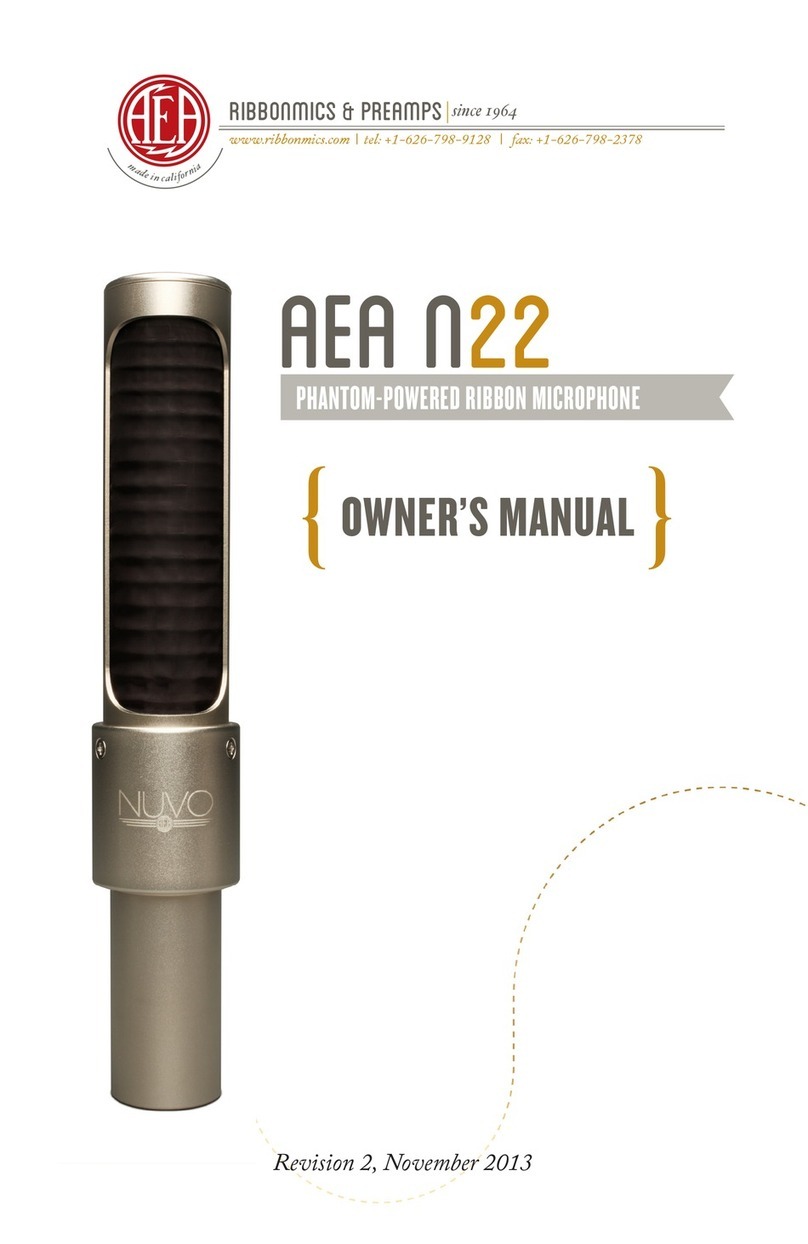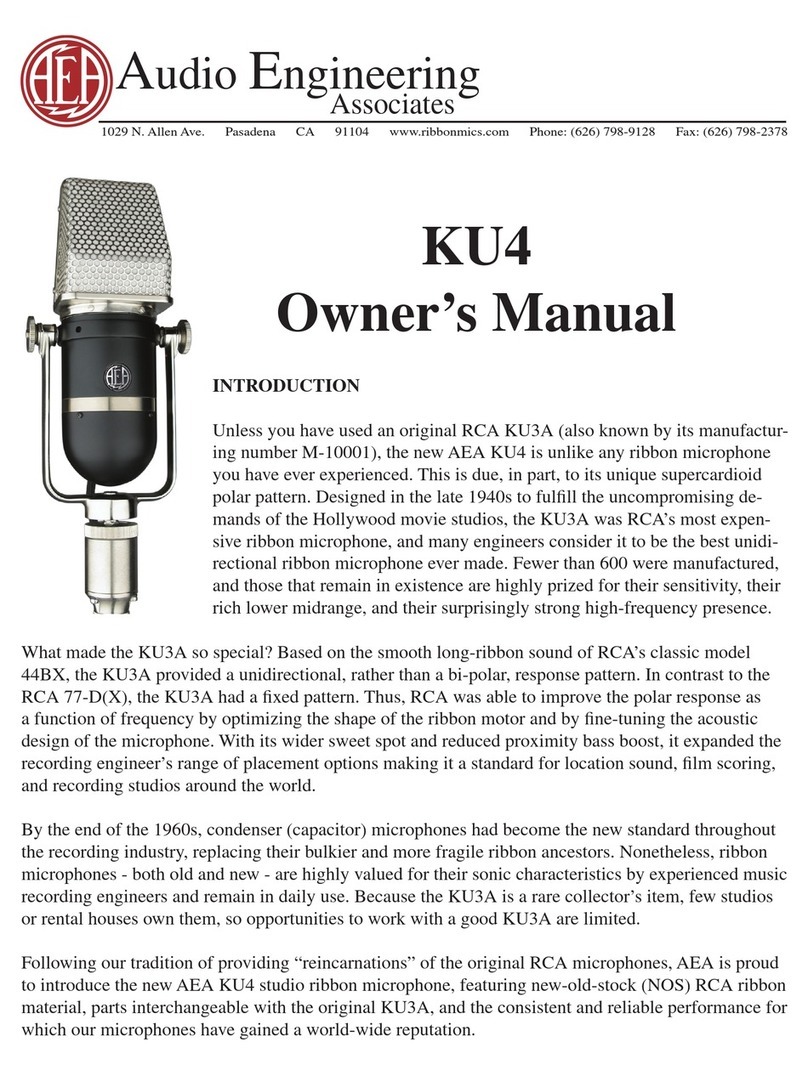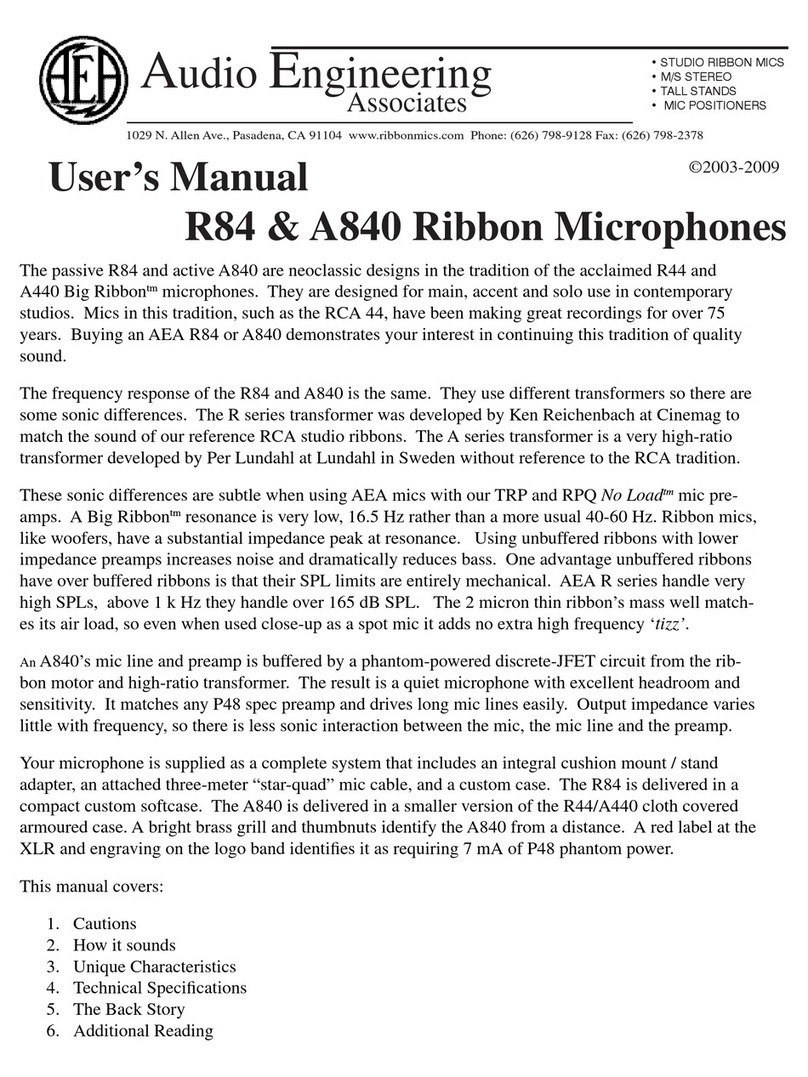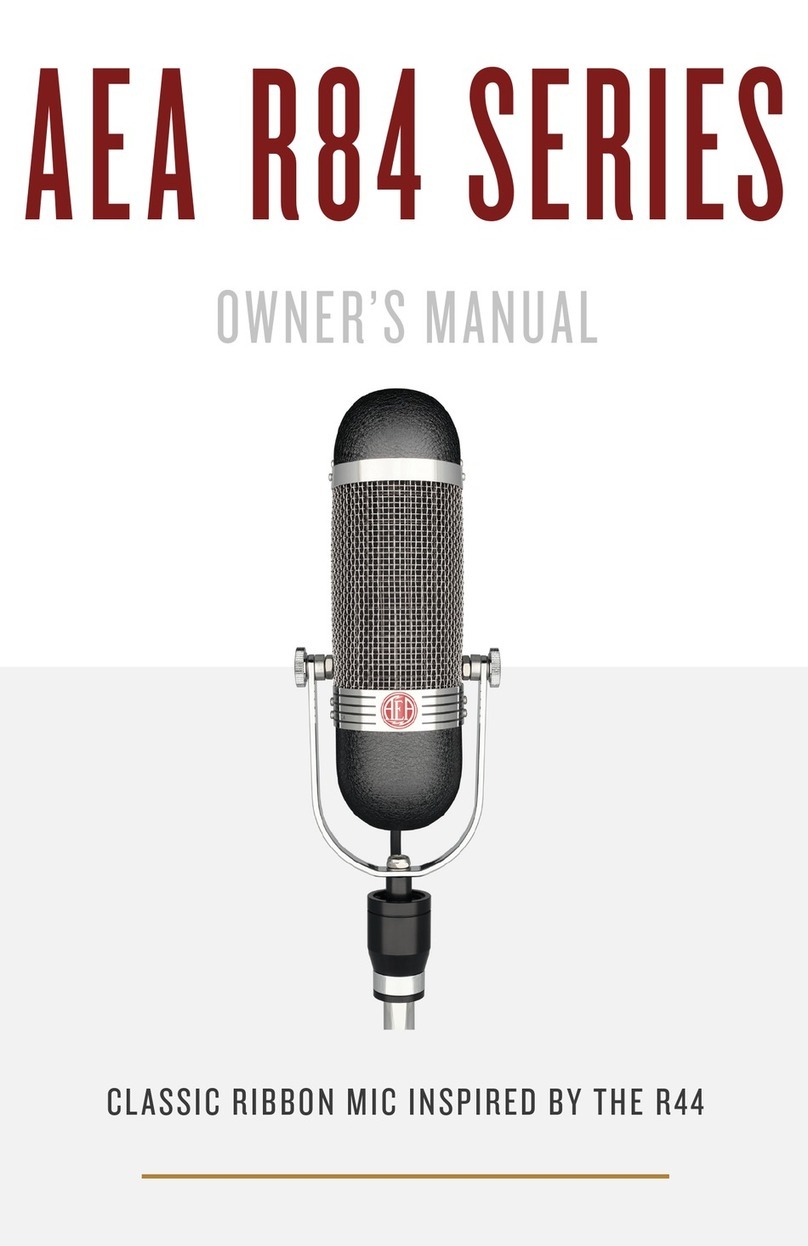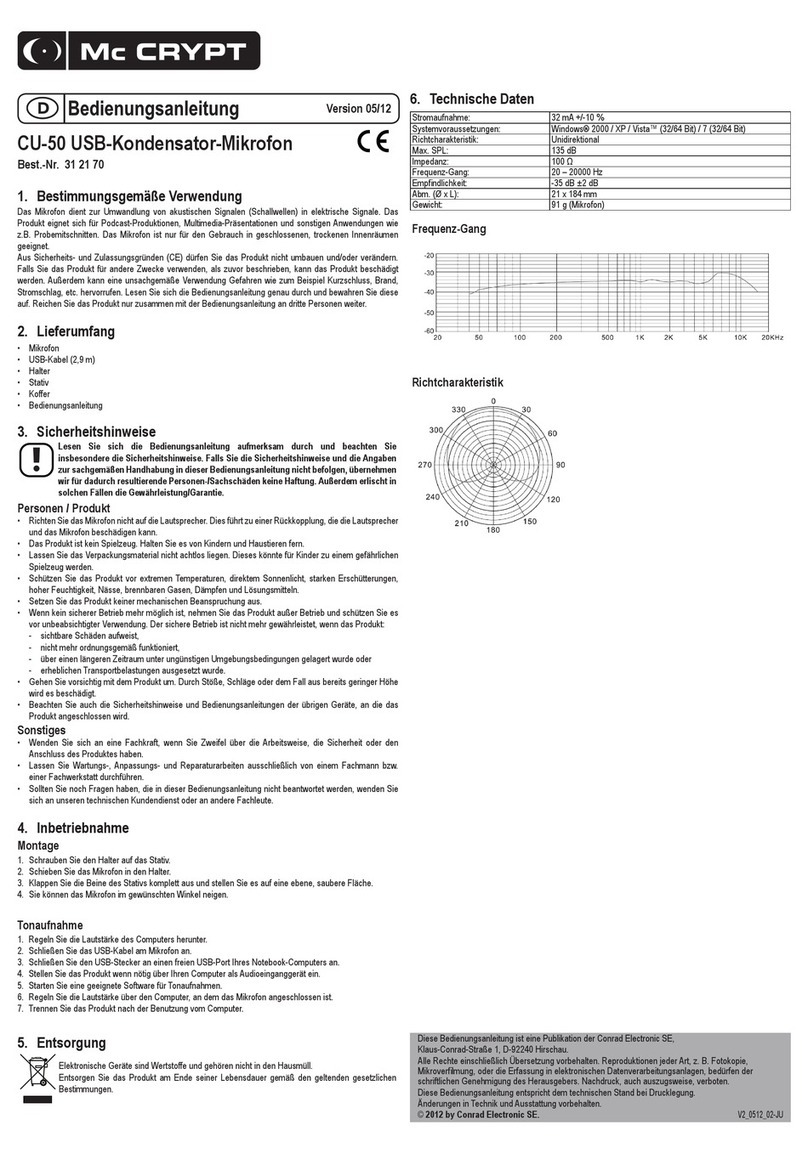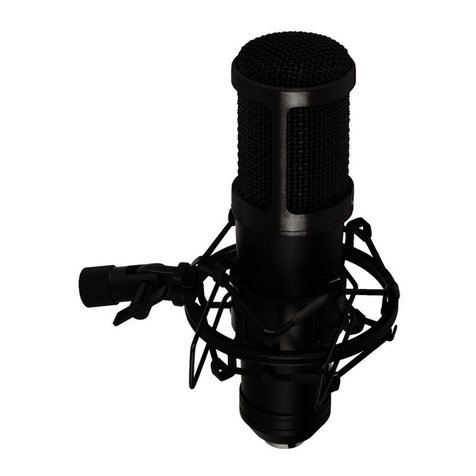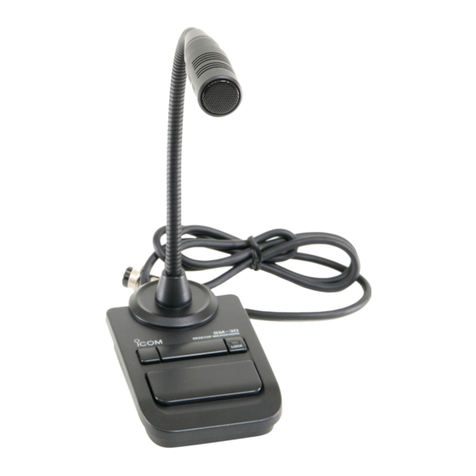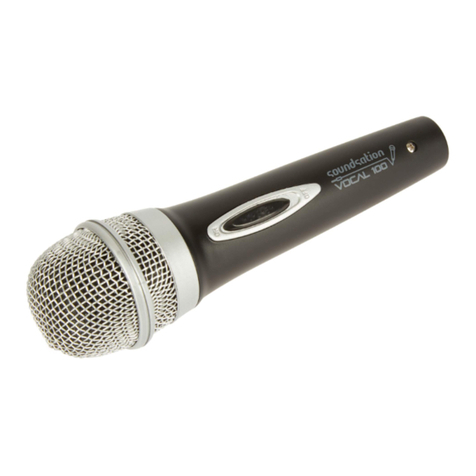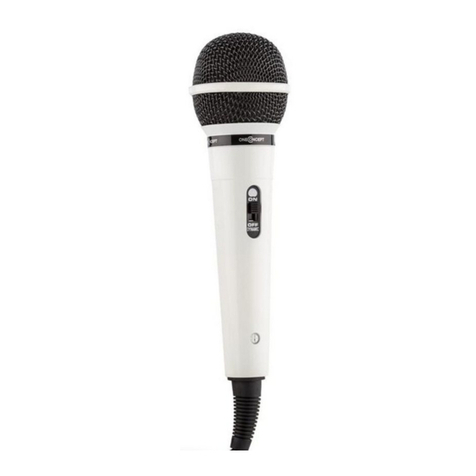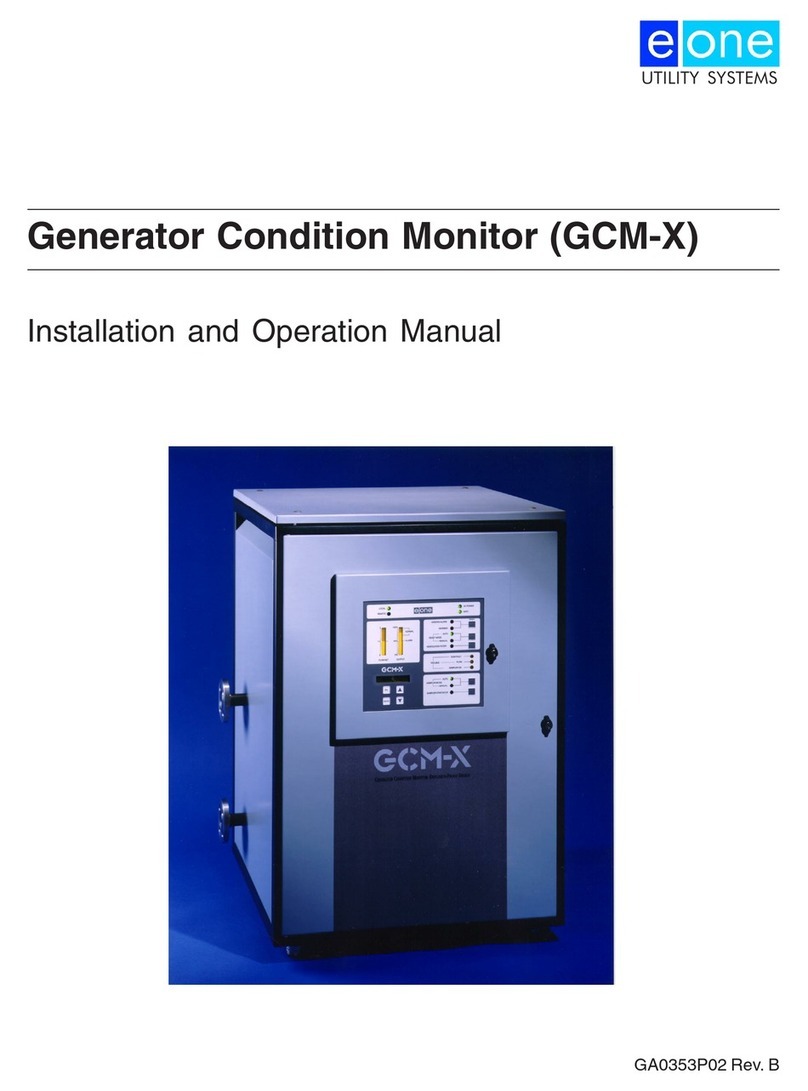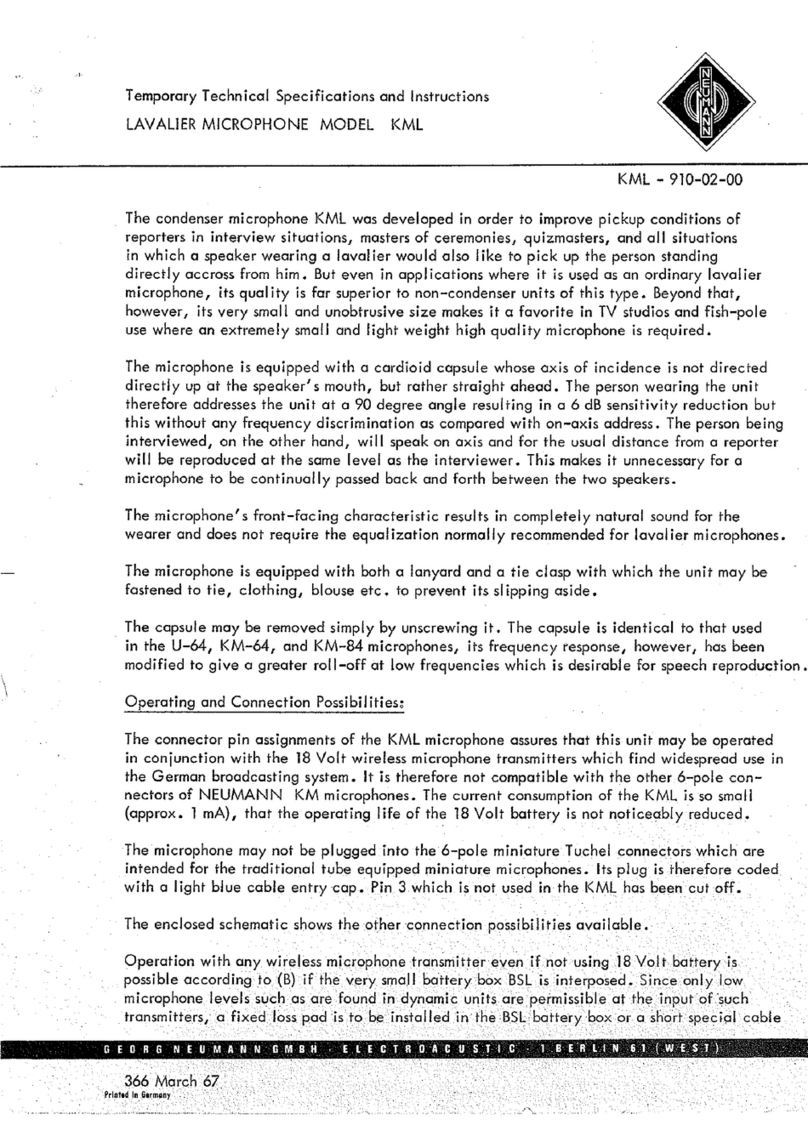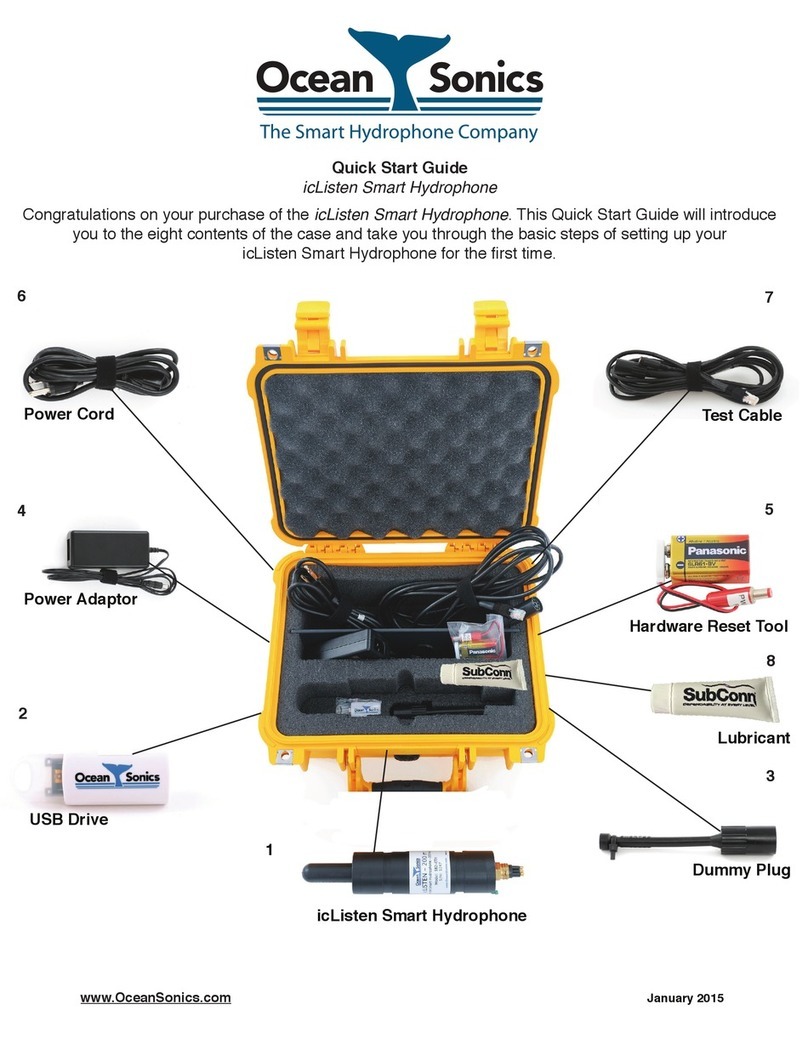AEA R44 User manual

THE CLASSIC RIBBON MICROPHONE
AEA R44
OWNER’S MANUAL

WELCOME
Congratulations on your purchase of the AEA R44 ribbon
microphone and welcome to the AEA family!
Whether it be the smooth brass section of a Hollywood soundtrack,
the velvety lushness of a jazz vocal, or the larger-than-life drum
sound of a classic rock record - chances are that you will find a 44
ribbon mic was used on most of your favorite albums. It is one of
the most iconic microphone designs in audio history. In studio use
for 85 years, the 44 ribbon design by RCA is legendary.
“The RCA 44B was the first great music microphone,” Les Paul once
told AEA’s Wes Dooley. “It sounds right on everything, every
instrument and voice.” RCA ceased production of the R44 in 1966.
After their microphone division was closed in 1976, AEA began
servicing ribbon microphones. By 1998, I decided to release our
own version of this classic mic. The 44’s recognizable sound
produces thunderous lows due to the strong proximity effect, a full
and rich mid-range, and a unique top-end taking the edge off of
harsh instruments. This beautiful, natural-sounding microphone
provides an unmatched authenticity of sonic reproduction,
particularly when placed at a distance in a well-tuned room.
Your R44 microphone is 100 percent handcrafted in Pasadena, CA.
AEA is a family-owned company with a small crew of skilled
technicians – most of them also musicians. Proudly independent,
we still manufacture all our ribbon microphones and preamps by
hand from locally sourced parts.
We hope the R44 will help you capture many magical performances
that touch the heart. Please read this manual thoroughly to make
sure that you get the best sound and longevity from your new
microphone. We invite you to become part of the AEA community
by sharing your experiences with the R44 via e-mail, phone or our
social media channels.
Wes Dooley
Founder of AEA 2

CONTENTS
WELCOME
INTRODUCTION
SUPPORT
GENERAL GUIDELINES
APPLICATION ADVICE
THE VARIANTS
SPECIFICATIONS
2
4
4
5
8
10
3
12

INTRODUCTION
The R44 is a passive, side address ribbon microphone with a
bidirectional (or figure-of-8) pickup pattern. It was designed to be a
part-for-part replica of the RCA R44 series, with the exception of
using neodymium rather than alnico magnets. Everything else,
including the 1.8 micron thick ribbon tuned to 16.5 Hz and the 1:28
transformer honors the legacy of this microphone. The versatile R44
gives modern engineers access to the vintage ribbon sound that
RCA pioneered. With its healthy low end, smooth and articulate
midrange, detailed high end, and lack of uncomfortable
resonances, the R44 is perfect for a variety of applications. Common
applications are vocals, strings, woodwinds, brass, guitars, and even
far-field drum recording, but the R44s smooth musicality is perfect
for nearly any recording situation. The microphone’s responsiveness
to proximity effect allows the engineer to “fix it in the mic” by
moving the microphone forward or backward to create the ideal low
end response. Whether used on vocals or instruments, the R44s
performance is warm, intimate, and accurate to the performance.
WARRANTY
Your R44 comes with a one-year
limited warranty on parts and labor,
shipping not included. Registering
your product with AEA will extend
the warranty to a full three years.
Scan the QR code or visit our website
to register.
SUPPORT
If you encounter any problems with your R44 microphone or have
additional questions regarding specific applications, please contact
our customer support team at [email protected] for the
quickest response.
To contact us by phone, please call +1-626-798-9128 from 9:00
a.m.- 5:00 p.m. PST Monday-Friday.AEA’s repair center is located at
1029 N. Allen Ave, Pasadena, CA 91104, U.S.A.
4

GENERAL GUIDELINES
5
PHANTOM POWER
Your microphone is a valuable and important investment. Like most
recording equipment and musical instruments, it requires common
sense and basic care to keep it functioning properly. Given care,
your new microphone will perform dependably for decades.
Phantom power is not required or recommended for the passive
R44. With a correctly wired cable and a properly working phantom
power supply, there is actually little danger of damaging the
microphone with phantom power. However, passive ribbons such
as the R44 can be damaged if ground (Pin 1) is accidently shorted,
miswired, or hot patched in a patch bay to (Pin 2) or (Pin 3). Using
phantom power with a faulty or miswired cable or a defective
supply can severely stretch or break a ribbon.
Since passive ribbon microphones and other transformer-coupled
microphones can be particularly vulnerable to phantom-power,
it is recommended to make disengaging phantom-power before
plugging and unplugging (the microphone) a habit.
MICROPHONE STORAGE
Keep the microphone covered when it is not in use. This will
reduce the damage that may result from a gust of air. Place the
supplied protective bag over the microphone when it is not in
use. For long-term storage, keep the microphone in its protective
case. An unprotected ribbon microphone can attract minute iron
particles, sometimes known as "tramp iron". If allowed, tramp iron
can penetrate the screen of a ribbon mic, sufficiently build up in
the magnetic gap and rub against the ribbon, causing distortion,
electrical shorts or tearing of the ribbon.

6
AIR TURBULENCE
Avoid exposing the microphone to strong air turbulence. Ribbon
microphones can withstand very high SPL (Sound Pressure Level),
but can be damaged by a strong gust of air or high levels of very
low frequency sound waves (from a kick drum or bass cabinet). This
can stretch the ribbon, reducing overall output, especially at high
frequencies.
Take precautions when recording any source that moves air. To
avoid damage, use "The Hand Test": put the back of your hand
where the mic will be positioned; if you can feel the moving air,
place a pop-filter between the microphone and the source or simply
pull the mic farther back. When recording kick drums or bass guitar
cabinets, angle the microphone so that no air blasts the microphone
directly on-axis from the front or back.
Never blow directly into any microphone to test it. Not only
does this force moisture and dirt into the microphone, but strong air
movement can stretch the ribbon.While the ribbon may not break,
it nonetheless could significantly degrade the microphone’s
performance. The ribbon in your R44 is protected from plosive and
direct wind blasts by both the diamond-shaped grille and its
acoustical fabric, as well as perforated metal and fabric blast
screens internally on each side of the ribbon. This design provides
good wind and breath blast protection, plus good high-end
response.
STRAY MAGNETIC FIELDS
Ribbon microphones are fundamentally prone to picking up strong
external magnetic fields generated by light dimmers or nearby
power transformers. Though AEA designers paid much attention to
suppressing such sensitivity, it is still possible that you might
encounter this problem. If you should pick up a hum, try rotating or
moving the microphone to find a spot where the hum disappears,
and try eliminating potential sources of stray magnetic fields. Rotate
or move the mic to find the point of peak interference.
The high-performance magnets used in AEA microphones are
incredibly strong, and a significant amount of stray magnetic field
lines surround the microphone. To prevent data loss caused by
magnetic fields, avoid placing the microphone in close proximity to
hard drives, credit cards, analog tape, or any other magnetically
sensitive items.

7
MICROPHONE POSITIONING
Always use a sturdy microphone stand with the R44. Weighing in at
over 8 pounds and more than 13 inches long, the R44 requires
mounting on a strong, robust microphone stand with a heavy base or
tripod. Large studio-booms with an appropriate counter-weight are
recommended to prevent your R44 from tipping-over and crashing,
causing injury to itself, a musician, or a valuable musical instrument.
The integrated cushion mount was designed to keep structure-borne
noise transmitted through the microphone stand and the cable away
from the low-tuned ribbon transducer. For the shock mount to
function as intended, it is important to vertically position the cushion
mount off of the mic stand and to rotate the microphone within the
yoke, as opposed to rotating the entire mic on the stand. This requires
the use of a swivel mount or Posi-Lock when using a boom arm for
positioning the microphone in a vertical configuration. Having the
cushion mount reaching out horizontally on a boom will cause inferior
vibration isolation and can also distort the cushion mount as time goes
by.

8
PROXIMITY EFFECT
Proximity effect, a characteristic of all directional microphones,
is a rise in low-frequency response at closer working distances.
This can be used to superb effect, particularly with deeper vocals
to enhance richness and depth. A potential trade-off is reduced
articulation resulting from the masking effect on the treble due to
“excessive” bass boost.
(graph is a visualization, not a measurement)
APPLICATIONS ADVICE
We actively encourage users to visit AEAribbonmics.com to
access our comprehensive collection of in-depth articles and
tutorials featuring the R44, along with a library of audio and
video demonstrations of the R44 in action.
If you are experiencing problems with your microphone, please
visit the following troubleshooting section of our website:
AEAribbonmics.com/support/troubleshooting-aea-products/

9
HOW TO MINIMIZE BLEED
A significant and ever-present challenge in contemporary studio
recording is minimizing leakage from nearby instruments into the
various microphones. The deep nulls of ribbon microphones provide
good rejection of unwanted sounds, which can be beneficial in sound
reinforcement situations where feedback is always a threat.
While gobo isolation panels can be effective in isolating performers
from each other, they introduce their own set of problems - including
reflections close to the performers and/or microphones that result in
comb-filter distortions. Because gobos usually are bulky and occupy
valuable floor space, they also inhibit the ability of the musicians to
hear and see each other easily. Such a setup requires complex and
often cumbersome headphone monitor mixes for the musicians.
A FIGURE-OF-8 MICROPHONE
Figure-of-8 microphones are constructed with positive polarity on
the front and negative polarity on the back. Positive pressure on
the front side of the ribbon produces a positive voltage on (Pin-2),
with respect to (Pin-3) on the output connector.

10
R44C - THE ORIGINAL
The R44C is an exact replica of the
RCA 44 born from years of experience
with RCA repairs. All components
are built to RCA specifications and
the sonic quality is entirely true to
the original. To record with an AEA
R44C is to participate in the legacy of
the most iconic ribbon mic in music
history.
R44 SERIES VARIANTS
Our R44 Series microphones all share the authentic sound,
feel and look of the original RCA 44. With careful technical
modifications, we've created several varitions to accommodate
modern applications and budgets.
R44CE - COST EFFECTIVE
To make the iconic sound of the
R44C more affordable, AEA
incorporated costeffective
exterior components that don’t
compromise build quality or
durability. It delivers precisely the
same sound as the R44C.

11
R44CX - HIGH OUTPUT
AEAdeveloped the X-motor as a
means of increasing the output
of the R44C without active
electronics. It comes equipped
with a modified R44 transducer
that includes two additional
magnets, providing an extra 6db
of output. It is visually
distinguished from the R44C by a
red logo badge on the
transformer case.
R44CXE - COST EFFECTIVE
This variation of the R44
incorporates the cost-effective
exterior components of the
R44CE with the addition of the
X-Motor for an additional 6dB of
output. It is visually distinguished
from the R44CE by a red logo
badge on the transformer case.

12
SPECIFICATIONS
DIMENSIONS & POLAR PATTERN
FREQUENCY RESPONSE
R44 Series
Operating Principle:
Directional Pattern:
Frequency Range:
Maximum SPL:
Sensitivity R44C/CE:
Sensitivity R44CX/CXE:
Output Impedance:
Rec Load Impedance:
Phantom Power:
Polarity:
Off-Axis Response
Horizontal:
Vertical:
Transducer Element
Material:
Thickness:
Width:
Length:
Microphone Dimensions
Height:
Width:
Depth:
Weight with cable:
Connector:
Pressure gradient transducer
Bidirectional
<20 Hz to >20 kHz
165+ dB SPL (1% third harmonic > 1 kHz)
2.25 mV/Pa (-53 dBV) into loaded circuit
4.47 mV/Pa (-47 dBV) into loaded circuit
270 Ohms Broadband
1.2 Ohms or greater
Not required or recommended
Pin 2 high for positive pressure on front of mic
Up to 90 dB rejection at right angles to the front
and back axis
Level changes with angle of incidence, but
frequency response is consistent
Pure aluminum corrugated ribbon
1.8 µm
0.185 in (4.7 mm)
2.35 in (59.7 mm)
12.25 in (31.1 cm)
4.62 in (11.7 cm)
3.25 in (8.3 cm)
7.9 lb (3.43 kg)
XLR-3M wired to a 10' (3 m) captive cable

13
DIMENSIONS & POLAR PATTERN
FREQUENCY RESPONSE
• Data below 200 Hz omitted due to measuring room restrictions
•0 dVB is equivalent to 2.5 mV/Pa (-52 dBV)for R44C/CE
•0 dVB is equivalent to 4.47 mV/Pa (-47 dBV) for R44CX/CXE
• Normalized to 0 dB at 1kHz. 1/3 octave smoothing
This manual suits for next models
1
Table of contents
Other AEA Microphone manuals

